December 2025

The Europe cell culture media market is projected to reach USD 1642.05 million by 2034, growing from USD 948.32 million in 2025, at a CAGR of 6.29% during the forecast period from 2025 to 2034. The growing research and development activities and technological advancements boost the market.
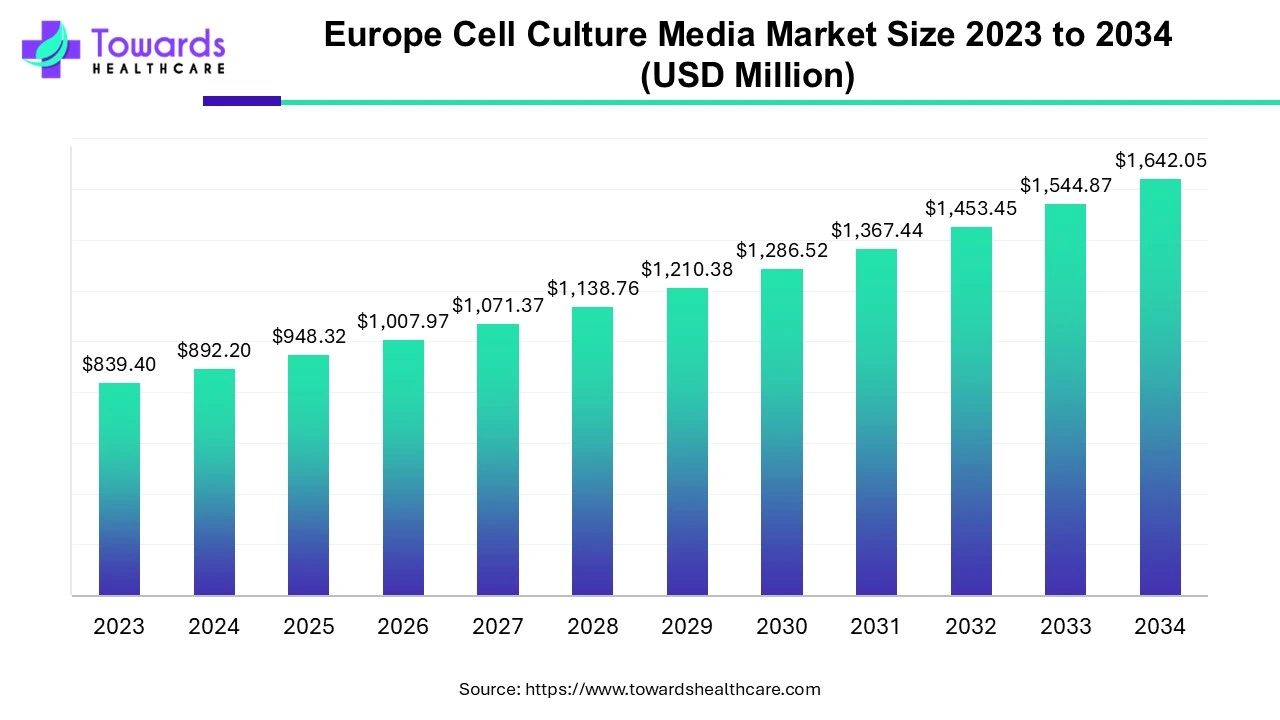
The culture medium is the powerhouse that contains several nutrients that aid in the development, proliferation, maintenance, and storage of microbial and other cell types, such as stem cells or other cell lines.
A growth medium, often referred to as a cell culture medium, is a solid, liquid, or semisolid medium that contains a variety of ingredients and nutrients and is used to support the growth, multiplication, maintenance, and storage of microorganisms, plant cells, mammalian cells, and other cell lines.
Artificial intelligence (AI) and machine learning (ML) algorithms have the potential to become an integral part of the cell culture technique. AI and ML can assist researchers in improving drug production from cell culture by fine-tuning and quantifying cell culture media experiments. They can suggest the type of cell culture media required depending on different experiments. They can also formulate media constituents based on personalized requirements. The selection of a suitable cell culture media enhances the accuracy and precision of biopharmaceutical production. Moreover, AI introduces automation in optimizing media formulations, leading to faster and better outcomes. AI can also help scale up media preparation and overcome challenges faced by conventional techniques.
New Technologies For Cell-Based Vaccines In Cell Culture
Cell culture technology has become a crucial component of vaccine production in the pharmaceutical sector. The development of vaccinations against polio, rotavirus, hepatitis, smallpox, chickenpox, and rubella is made easier by cell culture technologies. Additionally, the use of cell-based flu vaccinations has been allowed by the US and numerous European countries.
In the past, viruses were harvested and grown inside chicken eggs to create vaccinations, but this procedure was time-consuming. The cell-culture approach is currently being used to generate vaccines, which is far more effective than the conventional approach. The new cell-culture process makes it possible to produce a lot of vaccines quickly. Additionally, we can say that the vaccines made utilizing the cell-culture approach have a longer shelf life.
Difficult to Afford Treatment Related to Regenerative Medicine and Cell Culture
The high cost of tissue engineering and regenerative medicine restrains the market's expansion for cell culture media. Due to the monopolistic environment created by the limited supply of tissue engineering and regenerative medicine, the developing tissue engineering sector has difficulties. As there is less competition among suppliers, these services result in increased costs.
Evolution Of 3D Cell Culture
An artificial environment where biological cells are permitted to interact or develop with their surroundings is referred to as three-dimensional cell culture. Compared to cells grown in a 2D environment, those in a 3D environment tend to undergo larger physiological and morphological alterations. Researchers claim that this cellular makeup not only boosts gene expression but also cell-cell communication.
By type, the liquid media segment held a dominant presence in the Europe cell culture media market in 2024. Liquid media is highly preferred due to faster growth and higher isolation rates compared to solid media. The initial growth of microbes or cells are done in a liquid media, as it provides suitable nutrient requirements. It is primarily used to recover anaerobes and organisms present in low numbers in a specimen. The ease of sterility and transport from one vessel to another makes it suitable for diverse biotechnological applications.
By type, the semi-solid and solid media segment is predicted to witness significant growth in the market over the forecast period. Semi-solid and solid media provide sufficient support for growth. They are most widely preferred to grow microorganisms in their full physical form, prepare pure cultures, or isolate bacteria. Semi-solid media is an indication of the motility of microbes. The growing stem cell and drug development research promotes the use of solid and semi-solid media.
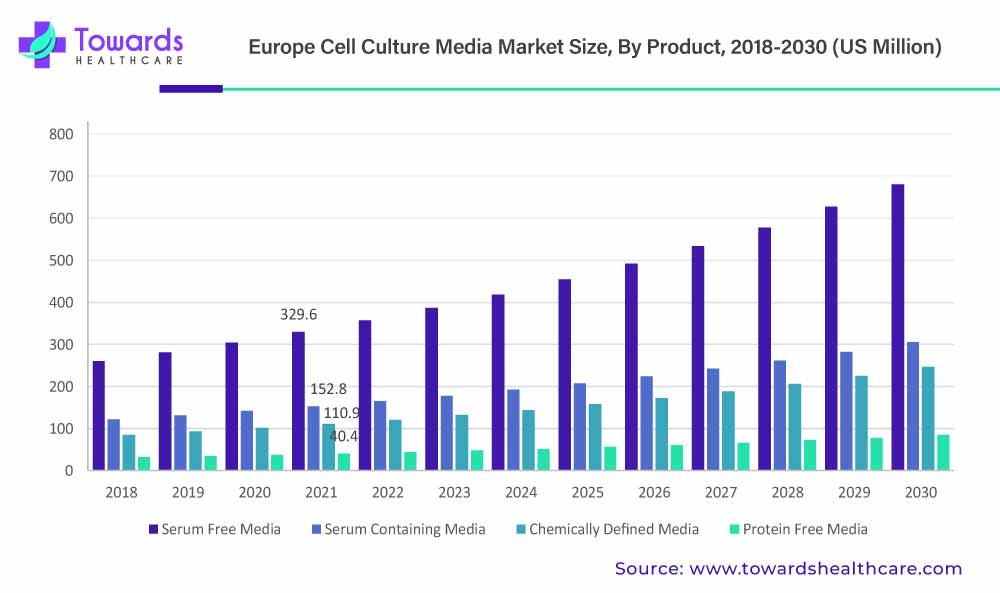
By product, the serum-free media segment led the Europe cell culture media market in 2024. Serum-free media does not consist of animal or human sera for culture growth. However, it contains appropriate nutritional and hormonal formulations. The demand for serum-free media is rising due to increased consistency and productivity as well as easier purification and downstream processing. Serum-free media finds diverse applications in pharmaceutical and biotechnology fields. Some of the common applications include the production of biologicals such as monoclonal antibodies, recombinant proteins, and adenovirus, the culture of kidney epithelial and related cells in virus production, and baculovirus expression vector system (BEVS).
By product, the stem culture media segment will gain a significant share of the market over the studied period. Stem cell culture media are exclusively used for the growth and proliferation of stem cells. The growing demand for stem cells due to rising incidences of chronic disorders and increasing research and development activities contribute to the segment’s growth. Stem cells are first grown on a culture media and transferred to the patient to provide suitable therapeutic effect.
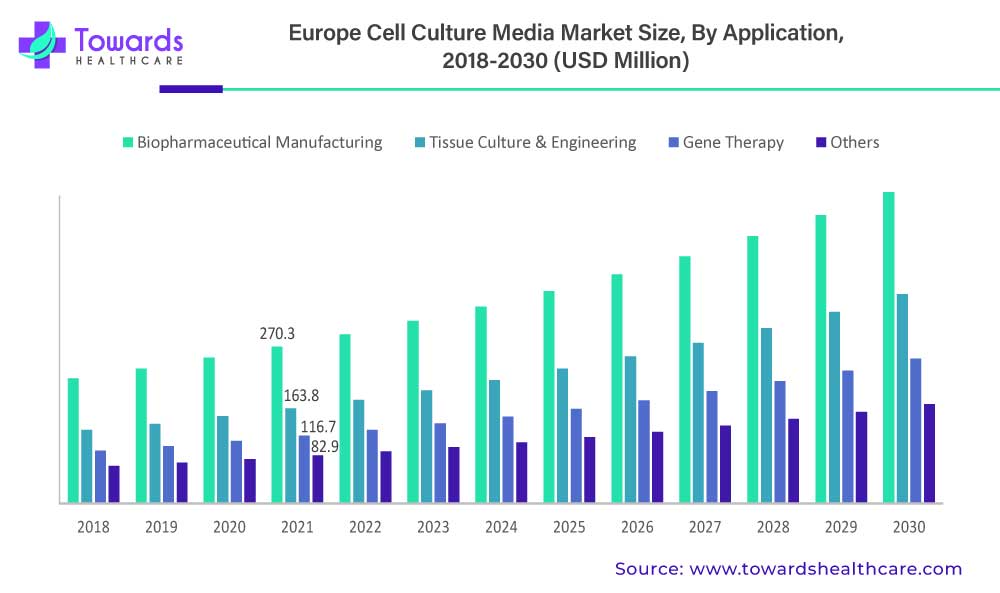
By application, the biopharmaceutical production segment registered its dominance over the global market in 2024. Cell culture media is an essential part of biopharmaceutical production as they provide essential nutrients for their growth. Numerous biopharmaceuticals, such as monoclonal antibodies, vaccines, and recombinant proteins, require cell culture media. Biopharmaceuticals provide targeted therapeutic action, unlike small molecules, thereby maximizing therapeutic benefit and minimizing toxicity. The increasing biopharmaceutical production globally, owing to its high demand, augments the segment’s growth. More than 16.5 million liters of active biopharmaceutical production capacity is estimated globally.
By application, the diagnostics segment is estimated to grow significantly in the Europe cell culture media market over the coming years. The rising incidences and prevalence of chronic disorders such as cancer and the rapidly expanding metabolomics field are the factors positively impacting the segment’s growth. Cell cultures are used to identify biomarkers of a pathological condition and study the metabolic pathways related to disease progression. The growing drug discovery research and the need for early detection of disease also boost the segment’s growth.
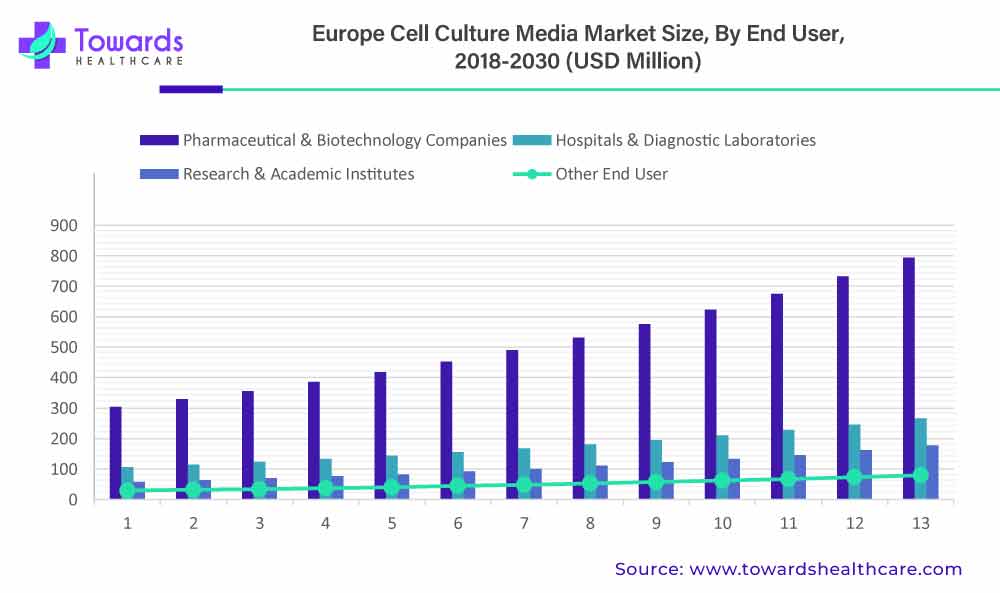
By end-use, the pharmaceutical & biotechnology companies segment held the largest share of the market in 2024. The segmental growth is attributed to state-of-the-art research and development activities, the presence of skilled professionals, and the continuous development of novel products. These companies have suitable infrastructure for conducting research related to cell culture techniques and storing cell culture media. Additionally, suitable capital investments augment the segment’s growth.
By end-use, the hospitals & diagnostic laboratories segment is anticipated to show lucrative growth in the Europe cell culture media market during the forecast period. The increasing number of patients in hospitals and diagnostic labs and the ability of cell culture media to identify potential biomarkers propel the segment’s growth. These settings have provisions to maintain and store media for testing purposes.
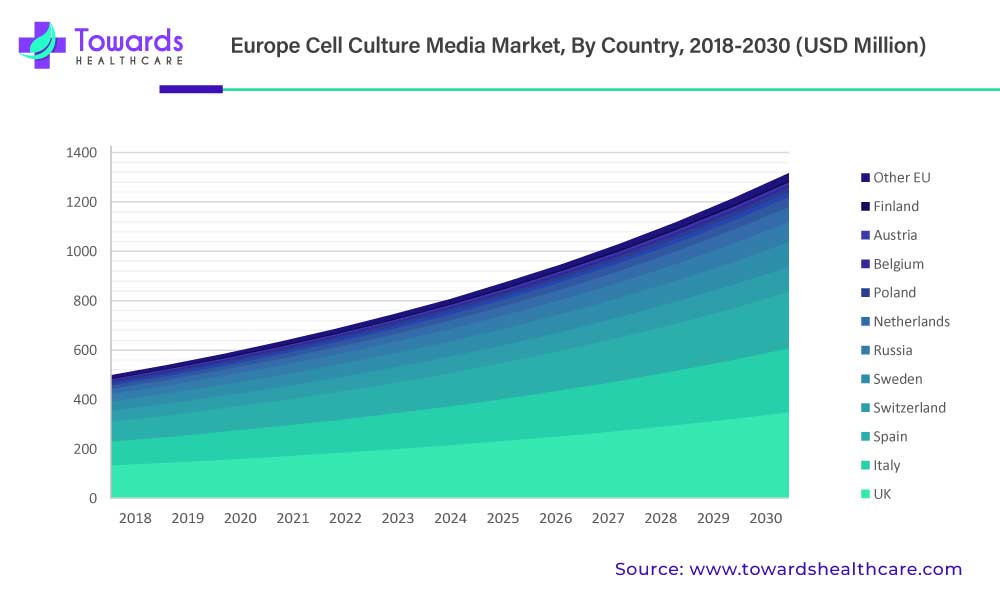
Europe is one of the top markets for cell and gene therapy, accounting for the second largest position internationally, with France and the United Kingdom leading the way. France is the European scaffold technology, cell culture, and media market leader. France's dominance was also dictated by the world's leading biotech and research hubs that are currently active in gene and cell therapy. Aside from that, the French government has resolved to boost gene therapy development by easing the acceptance of clinical trials since it was first described in human genome maps in 1990-92. Furthermore, the government encourages the collaboration of small gene therapy research facilities and hospitals, which encourages industry partners to invest in gene therapy initiatives.
The presence of key players providing cell culture media is a major growth factor for the UK market. The increasing biopharmaceutical R&D and manufacturing potentiate the demand for cell culture media. Biopharma R&D and manufacturing contributes a gross value-added (GVA) of around £20 billion annually to the UK economy. The rising number of biopharmaceutical startups also contributes to market growth. Favorable government policies and increasing investments augment the market growth in the UK. The UK government announced an investment of more than £100 million in the Synthetic Biology for Growth program by the UK Research and Innovation.
| Launches | Partnerships/ Collaborations/ Agreement |
| In October 2021, Thermo Fisher Scientific Inc. today announced the launch of Gibco Cell Therapy Systems (CTS) NK-Xpander Medium, a GMP-manufactured cell culture medium that supports large-scale growth and culture of functional natural killer (NK) cells with or without the use of feeder cells. | In June 2020, Corning Incorporated announced the launch of Corning Matrigel matrix-3D plates, pre-dispensed with Matrigel matrix to provide a more consistent and convenient, ready-to-use cell culture option to support organoid and spheroid culture models. |
In January 2025, Tim Mullane, president, FUJIFILM Irvine Scientific, a specialist in the innovation and manufacture of cell culture solutions for the life science and medical markets, announced it had agreed to sell its Medical Media Business Unit (MBU) to Astorg. This strategic acquisition expands the product portfolio of a new global MedTech company of Astorg by serving the assisted reproductive technology (ART) and IVF industry.
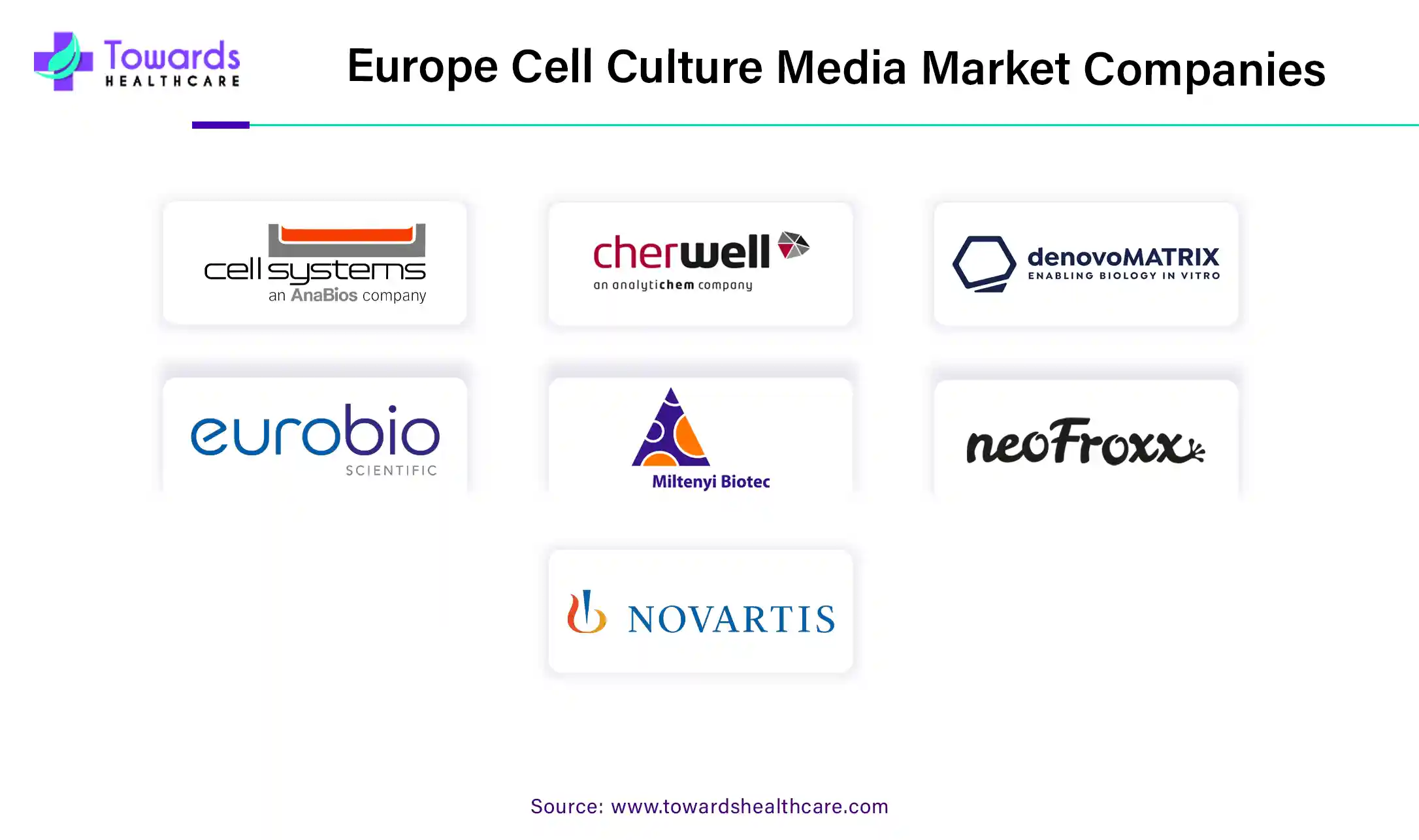
By Type
By Product
By Application
By End-Use
By Region
December 2025
December 2025
December 2025
November 2025